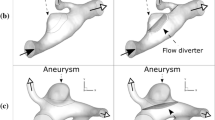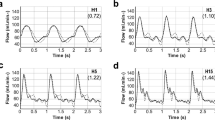Abstract
Purpose
Current flow diverter (FD) designs limit the possibilities to achieve ideal functional parameters for intra-aneurysmal flow alteration in the implanted state. In this work, we evaluate the technical feasibility of a new patient-specific FD concept and the impact on intra-aneurysmal flow reduction compared to standard FD.
Methods
Based on a literature review, we defined functional requirements, followed by the design and manufacturing of two different prototypes, which we implanted in a patient-specific phantom model. Functional porosity distributions and contour parameters were evaluated in the implanted state and compared to standard FD. Subsequently, we carried out a series of particle image velocimetry (PIV) measurements, in order to assess the impact on intra-aneurysmal flow.
Results
With both patient-specific prototypes, it was possible to achieve stronger intra-aneurysmal flow reductions in terms of maximum and mean velocity and vorticity than a standard FD; however, one design showed a strong sensitivity against malpositioning. Overall, fluid dynamics parameters correlated with geometrical aspects such as the porosity and its grade of homogeneity. Beyond that, we found influences by the FD contour projection within the aneurysm, especially connected to the formation of in-jets.
Conclusion
Our results show that there is a technically feasible concept, which enables a more specific adjustment of functional FD parameters and more effective intra-aneurysmal flow reduction. This could potentially lead to improvements in the efficacy of aneurysm occlusion in cases with challenging fluid dynamics.






Similar content being viewed by others
Abbreviations
- CFD:
-
Computational fluid dynamics
- FD:
-
Flow diverter
- IFD:
-
Individualized flow diverter
- PIV:
-
Particle imaging velocimetry
- WSS:
-
Wall shear stress
References
Briganti F, Leone G, Marseglia M, Mariniello G, Caranci F, Brunetti A, Maiuri F. Endovascular treatment of cerebral aneurysms using flow-diverter devices: a systematic review. Neuroradiol J. 2015;28:365–75.
Zhou G, Su M, Yin YL, Li MH. Complications associated with the use of flow-diverting devices for cerebral aneurysms: a systematic review and meta-analysis. Neurosurg Focus. 2017;42:E17.
Kallmes DF, Ding YH, Dai D, Kadirvel R, Lewis DA, Cloft HJ. A new endoluminal, flow-disrupting device for treatment of saccular aneurysms. Stroke. 2007;38:2346–52.
Shapiro M, Raz E, Becske T, Nelson PK. Variable porosity of the pipeline embolization device in straight and curved vessels: a guide for optimal deployment strategy. AJNR Am J Neuroradiol. 2014;35:727–33.
Makoyeva A, Bing F, Darsaut TE, Salazkin I, Raymond J. The varying porosity of braided self-expanding stents and flow diverters: an experimental study. AJNR Am J Neuroradiol. 2013;34:596–602.
Huang Q, Xu J, Cheng J, Wang S, Wang K, Liu JM. Hemodynamic changes by flow diverters in rabbit aneurysm models: a computational fluid dynamic study based on micro-computed tomography reconstruction. Stroke. 2013;44:1936–41.
Cebral JR, Mut F, Raschi M, Hodis S, Ding YH, Erickson BJ, Kadirvel R, Kallmes DF. Analysis of hemodynamics and aneurysm occlusion after flow-diverting treatment in rabbit models. AJNR Am J Neuroradiol. 2014;35:1567–73.
Chong W, Zhang Y, Qian Y, Lai L, Parker G, Mitchell K. Computational hemodynamics analysis of intracranial aneurysms treated with flow diverters: correlation with clinical outcomes. AJNR Am J Neuroradiol. 2014;35:136–42.
Ouared R, Larrabide I, Brina O, Bouillot P, Erceg G, Yilmaz H, Lovblad KO, Mendes Pereira V. Computational fluid dynamics analysis of flow reduction induced by flow-diverting stents in intracranial aneurysms: a patient-unspecific hemodynamics change perspective. J Neurointerv Surg. 2016;8:1288–93.
Boussel L, Rayz V, McCulloch C, Martin A, Acevedo-Bolton G, Lawton M, Higashida R, Smith WS, Young WL, Saloner D. Aneurysm growth occurs at region of low wall shear stress: patient-specific correlation of hemodynamics and growth in a longitudinal study. Stroke. 2008;39:2997–3002.
Xiang J, Natarajan SK, Tremmel M, Ma D, Mocco J, Hopkins LN, Siddiqui AH, Levy EI, Meng H. Hemodynamic-morphologic discriminants for intracranial aneurysm rupture. Stroke. 2011;42:144–52.
Meng H, Tutino VM, Xiang J, Siddiqui A. High WSS or low WSS? Complex interactions of hemodynamics with intracranial aneurysm initiation, growth, and rupture: toward a unifying hypothesis. AJNR Am J Neuroradiol. 2014;35:1254–62.
Gester K, Lüchtefeld I, Büsen M, Sonntag SJ, Linde T, Steinseifer U, Cattaneo G. In vitro evaluation of intra-aneurysmal, flow-diverter-induced thrombus formation: a feasibility study. AJNR Am J Neuroradiol. 2016;37:490–6.
Clauser J, Knieps MS, Büsen M, Ding A, Schmitz-Rode T, Steinseifer U, Arens J, Cattaneo G. A novel plasma-based fluid for particle image velocimetry (PIV): in-vitro feasibility study of flow diverter effects in aneurysm model. Ann Biomed Eng. 2018;46:841–8.
Bouillot P, Brina O, Ouared R, Lovblad K‑O, Farhat M, Pereira VM. Particle imaging velocimetry evaluation of intracranial stents in sidewall aneurysm: hemodynamic transition related to the stent design. PLoS One. 2014;9:e113762.
Zhang Y, Wang Y, Kao E, Flórez-Valencia L, Courbebaisse G. Towards optimal flow diverter porosity for the treatment of intracranial aneurysm. J Biomech. 2019;82:20–7.
Zhang M, Anzai H, Chopard B, Ohta M. Towards the patient-specific design of flow diverters made from helix-like wires: an optimization study. Biomed Eng Online. 2016;15(Suppl 2):159.
Augsburger L, Farhat M, Reymond P, Fonck E, Kulcsar Z, Stergiopulos N, Rüfenacht DA. Effect of flow diverter porosity on intraaneurysmal blood flow. Clin Neuroradiol. 2009;19:204–14.
Shojima M. Basic fluid dynamics and tribia related to flow diverter. J Neuroendovasc Ther. 2017;11:109–16.
Larrabide I, Geers AJ, Morales HG, Aguilar ML, Rüfenacht DA. Effect of aneurysm and ICA morphology on hemodynamics before and after flow diverter treatment. J Neurointervent Surg. 2015;7:272–80.
Shapiro M, Raz E, Becske T, Nelson PK. Building multidevice pipeline constructs of favorable metal coverage: a practical guide. AJNR Am J Neuroradiol. 2014;35:1556–61.
Cattaneo GFM, Ding A, Jost T, Ley D, Mühl-Bennighaus R, Yilmaz U, Körner H, Reith W, Simgen A. In vitro, contrast agent-based evaluation of the influence of flow diverter size and position on intra-aneurysmal flow dynamics using syngo iFlow. Neuroradiology. 2017;59:1275–83.
Janiga G, Daróczy L, Berg P, Thévenin D, Skalej M, Beuing O. An automatic CFD-based flow diverter optimization principle for patient-specific intracranial aneurysms. J Biomech. 2015;48:3846–52.
Zarrinkoob L, Ambarki K, Wåhlin A, Birgander R, Eklund A, Malm J. Blood flow distribution in cerebral arteries. J Cereb Blood Flow Metab. 2015;35:648–54.
Correia de Verdier M, Wikström J. Normal ranges and test-retest reproducibility of flow and velocity parameters in intracranial arteries measured with phase-contrast magnetic resonance imaging. Neuroradiology. 2016;58:521–31.
Ravindran K, Casabella AM, Cebral J, Brinjikji W, Kallmes DF, Kadirvel R. Mechanism of action and biology of flow diverters in the treatment of Intracranial aneurysms. Neurosurgery. 2020;86(Supplement_1):S13-9.
Bouillot P, Brina O, Ouared R, Lovblad K‑O, Farhat M, Pereira VM. Hemodynamic transition driven by stent porosity in sidewall aneurysms. J Biomech. 2015;48:1300–9.
Berg P, Iosif C, Ponsonnard S, Yardin C, Janiga G, Mounayer C. Endothelialization of over- and undersized flow-diverter stents at covered vessel side branches: an in vivo and in silico study. J Biomech. 2016;49:4–12.
Acknowledgements
We thank our colleagues from the ac.biomed GmbH, Aachen, Germany, who carried out the experiments and provided insight and expertise that greatly assisted the research, although they may not agree with all of the interpretations/conclusions of this paper.
Funding
This work was supported by the German Federal Ministry of Education and Research; grant number FKZ (13GW0274A-D).
Author information
Authors and Affiliations
Contributions
A. Ding: conception and main execution of the work and drafting the manuscript. A. Braschkat: substantial contribution to the acquisition and analysis of the work and revising the manuscript. A. Guber: substantial contributions to the interpretation of the work and revising it critically for important intellectual content. G. Cattaneo: substantial contributions to the design of the work and interpretation of results. Critical revision of the work for important intellectual content.
Corresponding author
Ethics declarations
Conflict of interest
A. Ding and A. Braschkat are employees of the Acandis GmbH, which financed the remaining costs, not covered by the public funding. A. Ding reports grants from the German Federal Ministry of Education and Research, during the conduct of the study. In addition, A. Ding has a patent system and procedure for braiding patient-specific stents (“Verfahren zum Flechten eines patientenspezifisch angepassten Stents”) pending to Acandis GmbH. A. Guber and G. Cattaneo declare that they have no competing interests.
Rights and permissions
About this article
Cite this article
Ding, A., Braschkat, A., Guber, A. et al. New Concept of Patient-specific Flow Diversion Treatment of Intracranial Aneurysms. Clin Neuroradiol 31, 671–679 (2021). https://doi.org/10.1007/s00062-020-00930-1
Received:
Accepted:
Published:
Issue Date:
DOI: https://doi.org/10.1007/s00062-020-00930-1




